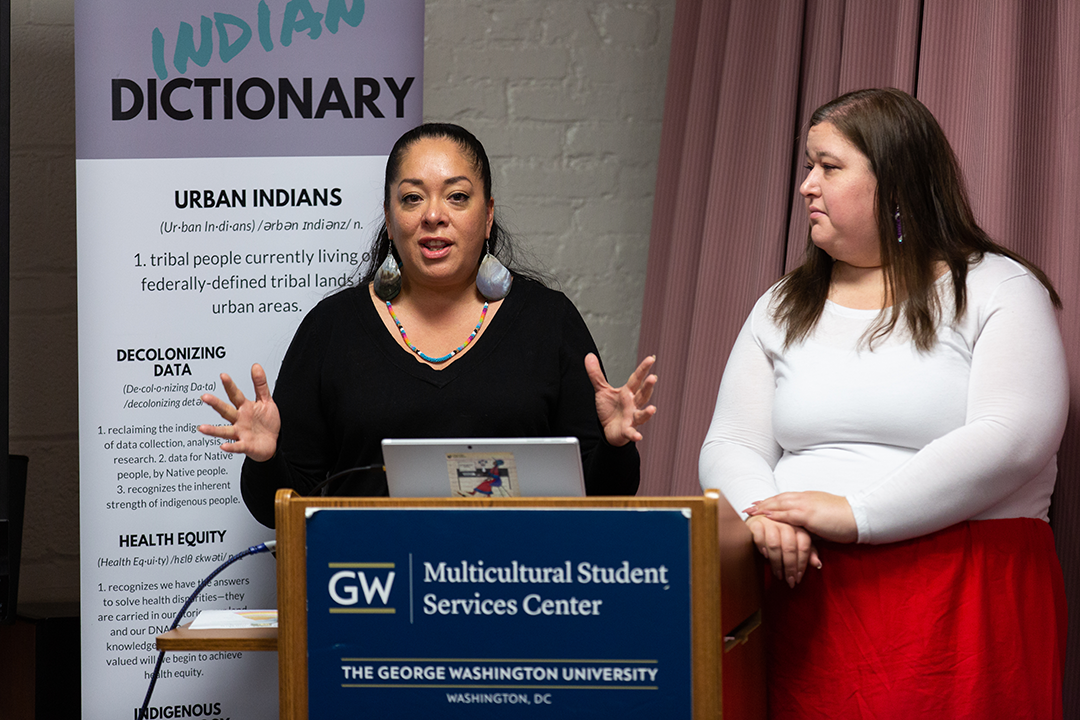By Briahnna Brown
There is a lack of data on the ongoing crisis of missing and slain Indigenous women and girls, which contributes to a false perception that the issue does not impact American Indian and Alaska Native women living off of reservations.
A newly released report from the Urban Indian Health Institute (UIHI) aims to change that.
During a community discussion hosted by the George Washington University AT&T Center for Indigenous Politics and Policy (CIPP) at the Multicultural Student Services Center (MSSC) on Thursday, the study’s lead researchers presented a snapshot of the missing indigenous women crisis in urban Indian communities and the challenges they faced in collecting this data.
The event took place during the Native American Heritage Celebration at GW, sponsored by MSSC, which promotes the values and traditions of American Indian and Alaska Native people through cultural events and educational programming throughout November.
Elizabeth Rule, assistant director of CIPP and a member of the Chickasaw nation, said that this report is a fundamental data resource that sheds light on the critical issue of missing and slain women, which is affecting indigenous communities nationwide.
“We honor these women, and we honor their families, they are the reason we're here,” Ms. Rule said. “Today, in this space as well as beyond, we will continue to remember them, to advocate for justice, to fight to ensure that data is decolonized, and their stories are told.”
A project like this had never been done before, so Abigail Echo-Hawk, director of UIHI and a member of the Pawnee nation, and Annita Lucchesi, a UIHI researcher and descendant of the Southern Cheyenne people, had to start from scratch.
The project was designed to assess how many cases of missing and slain indigenous women and girls there were and learn more about their stories and the dynamics of the violence they experienced. It also looked at how the community, law enforcement or the media could have responded better to these cases.

Abigail Echo-Hawk, director of Urban Indian Health Institute, discussed her organization's research into missing and slain Indigenous women.
Of the 506 cases identified in the report, 128 were missing persons cases, 280 were homicides and 98 were cases with an unknown status. The earliest case occurred in 1943, but two-thirds of cases in the report are from 2010-2018. The oldest victim identified was 83 years old, and the youngest was less than 1 year old.
The data was collected from law enforcement records, state and national databases, media coverage, social media and community and family member accounts of these incidents. Ms. Lucchesi said they stressed community-driven data practices while gathering information, such as including tribal affiliation, whenever possible because law enforcement or the media often failed to do so.
“[Tribal affiliation] means everything to us because it's where those women come from, it's who they belong to, it's the cultural protocols that are wrapped up in responding to the case and honoring the grief that the family is going through, and it's understanding the dynamics of the case,” Ms. Lucchesi said. “That's critical, and yet no one was doing it.”
Researchers face several challenges in collecting this data, such as unanswered Freedom of Information Act requests, poor record keeping at law enforcement agencies—which included racial misclassification and systems defaulting victims’ race as white—and a lack of digitized records in understaffed records departments.
Ms. Lucchesi also cited a lack of cooperation from law enforcement agencies, high fees for accessing records, underreporting of these cases and a lack of media coverage as additional challenges they faced while compiling the report.
Because of these various challenges, Ms. Lucchesi explained, the 506 identified cases are likely an undercount of the missing and slain indigenous women and girls in urban areas.
Ms. Echo-Hawk recognized that there is more work to do as they strive for identifying more cases and acquiring more data. She explained that she saw herself and her relatives in this data, and it drives her to continue advocating for indigenous women and girls.
“I would feel this thing in my heart and my soul that said I don't want to see another relative in this,” Ms. Echo-Hawk said of the data they collected. “When I think about why I did this, it was for all the women in Indian country, but I see in my head my little nieces...the ones who should never, ever be in this data.”




